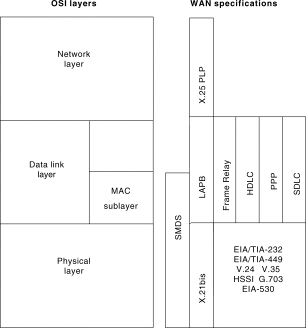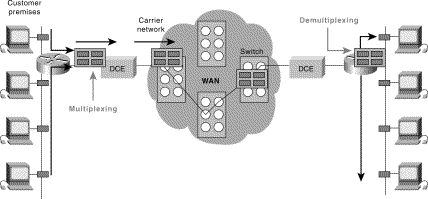Introduction to WAN Technologies
2008-02-22 12:37:39来源:互联网 阅读 ()

Introduction to WAN Technologies
What Is a WAN?
Point-to-Point Links
Circuit Switching
Packet Switching
WAN Virtual Circuits
WAN Dialup Services
WAN Devices
WAN Switch
Access Server
Modem
CSU/DSU
ISDN Terminal Adapter
Review Questions
For More Information
Chapter Goals
- Become familiar with WAN terminology.
- Learn about different types of WAN connections.
- Become familiar with different types of WAN equipment.
Introduction to WAN Technologies
This chapter introduces the various protocols and technologies used in wide-area network (WAN) environments. Topics summarized here include point-to-point links, circuit switching, packet switching, virtual circuits, dialup services, and WAN devices. Chapters in Part III, "WAN Protocols," address specific technologies in more detail.
What Is a WAN?
A WAN is a data communications network that covers a relatively broad geographic area and that often uses transmission facilities provided by common carriers, such as telephone companies. WAN technologies generally function at the lower three layers of the OSI reference model: the physical layer, the data link layer, and the network layer. Figure 3-1 illustrates the relationship between the common WAN technologies and the OSI model.
Figure 3-1: WAN Technologies Operate at the Lowest Levels of the OSI Model
Point-to-Point Links
A point-to-point link provides a single, pre-established WAN communications path from the customer premises through a carrier network, such as a telephone company, to a remote network. Point-to-point lines are usually leased from a carrier and thus are often called leased lines. For a point-to-point line, the carrier allocates pairs of wire and facility hardware to your line only. These circuits are generally priced based on bandwidth required and distance between the two connected points. Point-to-point links are generally more expensive than shared services such as Frame Relay. Figure 3-2 illustrates a typical point-to-point link through a WAN.
Figure 3-2: A Typical Point-to-Point Link Operates Through a WAN to a Remote Network
Circuit Switching
Switched circuits allow data connections that can be initiated when needed and terminated when communication is complete. This works much like a normal telephone line works for voice communication. Integrated Services Digital Network (ISDN) is a good example of circuit switching. When a router has data for a remote site, the switched circuit is initiated with the circuit number of the remote network. In the case of ISDN circuits, the device actually places a call to the telephone number of the remote ISDN circuit. When the
two networks are connected and authenticated, they can transfer data. When the data transmission is complete, the call can be terminated. Figure 3-3 illustrates an example of this type of circuit.
Figure 3-3: A Circuit-Switched WAN Undergoes a Process Similar to That Used for a Telephone Call 
Packet Switching
Packet switching is a WAN technology in which users share common carrier resources. Because this allows the carrier to make more efficient use of its infrastructure, the cost to the customer is generally much better than with point-to-point lines. In a packet switching setup, networks have connections into the carrier's network, and many customers share the carrier's network. The carrier can then create virtual circuits between customers' sites by which packets of data are delivered from one to the other through the network. The section of the carrier's network that is shared is often referred to as a cloud.
Some examples of packet-switching networks include Asynchronous Transfer Mode (ATM), Frame Relay, Switched Multimegabit Data Services (SMDS), and X.25. Figure
3-4 shows an example packet-switched circuit.
The virtual connections between customer sites are often referred to as a virtual circuit.
Figure 3-4: Packet Switching Transfers Packets Across a Carrier Network 
本新闻共3页,当前在第1页 1 2 3
标签:
版权申明:本站文章部分自网络,如有侵权,请联系:west999com@outlook.com
特别注意:本站所有转载文章言论不代表本站观点,本站所提供的摄影照片,插画,设计作品,如需使用,请与原作者联系,版权归原作者所有
上一篇:pim通用规则
IDC资讯: 主机资讯 注册资讯 托管资讯 vps资讯 网站建设
网站运营: 建站经验 策划盈利 搜索优化 网站推广 免费资源
网络编程: Asp.Net编程 Asp编程 Php编程 Xml编程 Access Mssql Mysql 其它
服务器技术: Web服务器 Ftp服务器 Mail服务器 Dns服务器 安全防护
软件技巧: 其它软件 Word Excel Powerpoint Ghost Vista QQ空间 QQ FlashGet 迅雷
网页制作: FrontPages Dreamweaver Javascript css photoshop fireworks Flash
